Patio de Leon Fountains
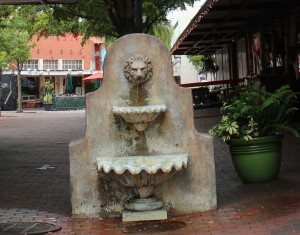 The City of Fort Myers public art ordinance includes fountains within the ambit of public art, and the River District’s Patio de Leon contains three. At the entries to the plaza off First and Main Streets are concrete Lion’s head fountains, from which Patio de Leon derives its name, but the centerpiece of the courtyard is a decorative eight-sided stained concrete fountain crowned by a rotating granite sphere and eight climbing stone alligators.
The City of Fort Myers public art ordinance includes fountains within the ambit of public art, and the River District’s Patio de Leon contains three. At the entries to the plaza off First and Main Streets are concrete Lion’s head fountains, from which Patio de Leon derives its name, but the centerpiece of the courtyard is a decorative eight-sided stained concrete fountain crowned by a rotating granite sphere and eight climbing stone alligators.
 No information has been found that identifies the artist who created these fountains. It appears that the lion’s head fountains were placed in the alleyways leading into the courtyard sometime in 1924, when New Port Richey developer George W. Sims purchased the property and changed the name to Patio de Leon. It also appears the alligator fountain is a replica or homage of another fountain that was added to the plaza during the makeover that Sims gave the plaza after he purchased the court. No information has been uncovered that reveals what happened to the original fountain, but it was reconstructed in the 1990s and redesigned in 2010 as a replica or homage to the fountain that stood on its site between the mid-1920s and 1930s.
No information has been found that identifies the artist who created these fountains. It appears that the lion’s head fountains were placed in the alleyways leading into the courtyard sometime in 1924, when New Port Richey developer George W. Sims purchased the property and changed the name to Patio de Leon. It also appears the alligator fountain is a replica or homage of another fountain that was added to the plaza during the makeover that Sims gave the plaza after he purchased the court. No information has been uncovered that reveals what happened to the original fountain, but it was reconstructed in the 1990s and redesigned in 2010 as a replica or homage to the fountain that stood on its site between the mid-1920s and 1930s.
History of the Patio de Leon Fountain
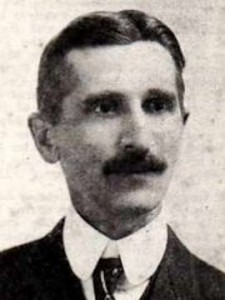 At the First Street entrance to Patio de Leon is a fountain with a lion’s head on it, from which Patio de Leon takes its name. Originally known as Tonnelier Court, Patio de Leon was developed by a retired banker from Benton Harbor, Michigan by the name of Peter Tonneliar. Between 1913 and 1915, he erected most of the buildings in the courtyard, including a huge wooden Vaudeville theater known as Omar Theatre and nicknamed the Ritz. At the same time, Tonnelier paved the courtyard and installed planter beds, park seating and a cement and brick aquarium that held small alligators. From then on, the north-south concourse of the court was known as “Alligator Way.” [A portion of Tonneliar’s aquarium
At the First Street entrance to Patio de Leon is a fountain with a lion’s head on it, from which Patio de Leon takes its name. Originally known as Tonnelier Court, Patio de Leon was developed by a retired banker from Benton Harbor, Michigan by the name of Peter Tonneliar. Between 1913 and 1915, he erected most of the buildings in the courtyard, including a huge wooden Vaudeville theater known as Omar Theatre and nicknamed the Ritz. At the same time, Tonnelier paved the courtyard and installed planter beds, park seating and a cement and brick aquarium that held small alligators. From then on, the north-south concourse of the court was known as “Alligator Way.” [A portion of Tonneliar’s aquarium 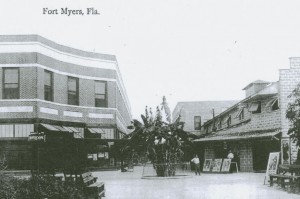 can be seen in the lower left corner of the photograph to the left. The fountain that is in the courtyard today is located just to the right of the palm tree in the center of the photo.]
can be seen in the lower left corner of the photograph to the left. The fountain that is in the courtyard today is located just to the right of the palm tree in the center of the photo.]
In 1924, New Port Richey developer George W. Sims embarkded on an ambitious makeover of the plaza, which he renamed Patio de Leon. A well-known Florida 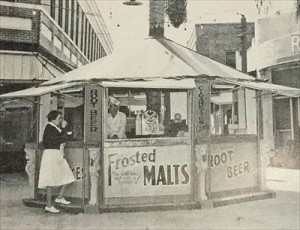 artist by the name of Thomas R. Martin was commissioned for this purpose, and in furtherance of his design, the building surrounding the patio were given a Spanish-style motif and palm trees, flowering plants and fountains were incorporated into the patio to give the plaza a more European look. A year later, the Ritz burned to the ground, although it is survived by the 1916 building that was once its ticket office. That building today is home
artist by the name of Thomas R. Martin was commissioned for this purpose, and in furtherance of his design, the building surrounding the patio were given a Spanish-style motif and palm trees, flowering plants and fountains were incorporated into the patio to give the plaza a more European look. A year later, the Ritz burned to the ground, although it is survived by the 1916 building that was once its ticket office. That building today is home 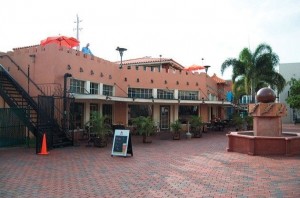 to Space 39, which has retained the structure’s original Moorish influenced turned columns and prominent scalloped arch.
to Space 39, which has retained the structure’s original Moorish influenced turned columns and prominent scalloped arch.
A prominent feature of the redesigned patio was a decorative eight-sided fountain that was erected on the site of the plaza’s current fountain next to the 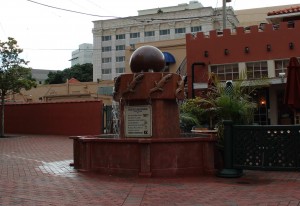 Prime de Leon Restaurant. The fountain is reputed to have held two large alligators, a carryover from Tonneliar’s aquarium. The gators became a tourist attraction that drew large crowds to the patio. But after several children lost fingers, the fountain was replaced with a fruit and soda stand sometime during the 1930s. That too was removed in the 1960s.
Prime de Leon Restaurant. The fountain is reputed to have held two large alligators, a carryover from Tonneliar’s aquarium. The gators became a tourist attraction that drew large crowds to the patio. But after several children lost fingers, the fountain was replaced with a fruit and soda stand sometime during the 1930s. That too was removed in the 1960s.
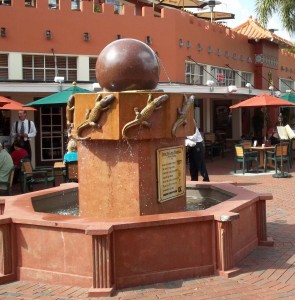 The current fountain was built in the 1990s in homage to its early predecessors, and was redesigned in 2010. Today, Peter Tonneliar’s beautiful patio provides a soothing backdrop for relaxing and entertaining. The fountain itself is composed of stained concrete crowned by a rotating granite orb. Stone alligators surround the upper portion of the fountain in tribute to the fountain’s early history.
The current fountain was built in the 1990s in homage to its early predecessors, and was redesigned in 2010. Today, Peter Tonneliar’s beautiful patio provides a soothing backdrop for relaxing and entertaining. The fountain itself is composed of stained concrete crowned by a rotating granite orb. Stone alligators surround the upper portion of the fountain in tribute to the fountain’s early history.
About Peter Tonnelier
P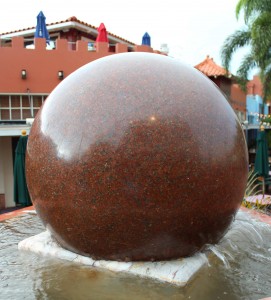 eter Tonnelier owned a number of Michigan drug stores when he first came to winter in St. Petersburg in 1910. Two years later, he visited Fort Myers by chance after high winds on forced him to seek shelter up the Caloosahatchee River during a boat trip on the Gulf of Mexico. Historian Karl Grismer noted that when Tonnelier arrived, the section between Hendry and Monroe streets “consisted mostly of ramshackle wooden buildings.”
eter Tonnelier owned a number of Michigan drug stores when he first came to winter in St. Petersburg in 1910. Two years later, he visited Fort Myers by chance after high winds on forced him to seek shelter up the Caloosahatchee River during a boat trip on the Gulf of Mexico. Historian Karl Grismer noted that when Tonnelier arrived, the section between Hendry and Monroe streets “consisted mostly of ramshackle wooden buildings.”
Over the next 10 years, Grismer relates, Tonnelier purchased 52 parcels, building hotels and donating the property for 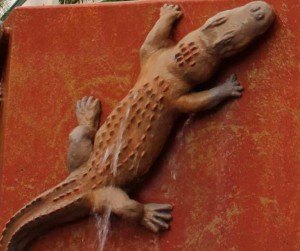 Main Street. He started what is now Patio de Leon in 1913 and put up most of the buildings around the courtyard. But oddly, no building or street in Fort Myers bears his name. The plaque on the central fountain in Patio de Leon mentions George W. Sims’ 1924 redevelopment of what was known as “Tonnelier Court.” Tonnelier’s first name is not on the plaque.
Main Street. He started what is now Patio de Leon in 1913 and put up most of the buildings around the courtyard. But oddly, no building or street in Fort Myers bears his name. The plaque on the central fountain in Patio de Leon mentions George W. Sims’ 1924 redevelopment of what was known as “Tonnelier Court.” Tonnelier’s first name is not on the plaque.
Fort Myers’ historic perseveration coordinator Jared Beck 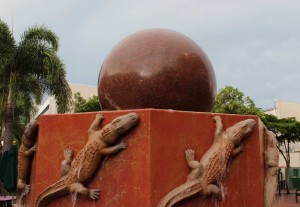 ranks Tonnelier as one of the early 20th century’s three most important downtown figures with John Morgan Dean and Harvie Heitman.
ranks Tonnelier as one of the early 20th century’s three most important downtown figures with John Morgan Dean and Harvie Heitman.
Tonnelier died in 1932, just before turning 72.
Dimensions and Location.
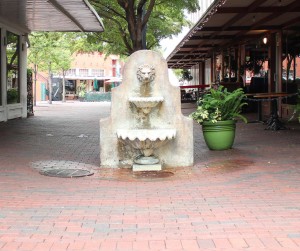 The lion’s head fountain at the entry of the north alley leading to Patio de Leon is located at 2223 First Street, Fort Myers, FL 33901.
The lion’s head fountain at the entry of the north alley leading to Patio de Leon is located at 2223 First Street, Fort Myers, FL 33901.- It is located at longitude 26 deg, 38′ 38.8032″ N and latitude 81 deg, 52′ 12.8854″ W.
- The lion’s head fountain at the entry of the south alley leading to Patio de Leon is located at 2213 Main Street, Fort Myers, FL 33901.
- It is located at longitude 26 deg, 38′ 35.4373″ N and latitude 81 deg, 52′ 11.128″ W.
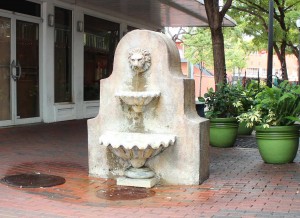 The alligator fountain is located at 33 Ponce de Leon, Fort Myers, FL 33901.
The alligator fountain is located at 33 Ponce de Leon, Fort Myers, FL 33901.- It is located at longitude 26 deg, 38′ 37.6295″ N and latitude 81 deg, 52′ 11.6687″ W.
Fast Facts.
No information has been discovered that identifies the fountains’ owner.














 Tom Hall is both an amateur artist and aspiring novelist who writes art quest thrillers. He is in the final stages of completing his debut novel titled "Art Detective," a story that fictionalizes the discovery of the fabled billion-dollar Impressionist collection of Parisian art dealer Josse Bernheim-Jeune, thought by many to have perished during World War II when the collection's hiding place, Castle de Rastignac in southern France, was destroyed by the Wehrmacht in reprisal for attacks made by members of the Resistance operating in the area. A former tax attorney, Tom holds a bachelor's degree as well as both a juris doctorate and masters of laws in taxation from the University of Florida. Tom lives in Estero, Florida with his fiancee, Connie, and their four cats.
Tom Hall is both an amateur artist and aspiring novelist who writes art quest thrillers. He is in the final stages of completing his debut novel titled "Art Detective," a story that fictionalizes the discovery of the fabled billion-dollar Impressionist collection of Parisian art dealer Josse Bernheim-Jeune, thought by many to have perished during World War II when the collection's hiding place, Castle de Rastignac in southern France, was destroyed by the Wehrmacht in reprisal for attacks made by members of the Resistance operating in the area. A former tax attorney, Tom holds a bachelor's degree as well as both a juris doctorate and masters of laws in taxation from the University of Florida. Tom lives in Estero, Florida with his fiancee, Connie, and their four cats.